
Is your mind always spinning from doing laundry? Should you wash your jacket with cold water or warm water? Confused about what the laundry symbols found on clothing labels mean? If thoughts of this nature run through your mind whenever it’s laundry day, then you’ve come to the right place.
To answer those questions and other laundry-related queries, you need to learn how to decipher laundry symbols. Laundry symbols provide important information on how to best take care of our clothes and linens. They tell us how to wash, dry, bleach, and iron in the proper way. If you want your garments to last long, you better be familiar with how to take care of all of them! Where to find these symbols? You can find them in most shirts, shorts, pants, jackets — nearly all items of clothing that are washable and wearable. Before you put your clothes inside the laundry machine, you need to look at the labels on them.
If you feel like you’re studying very complicated hieroglyphics, don’t worry, we won’t judge you. At the onset, it’s easy to get overwhelmed by so many clothing care symbols. No need to worry! Our detailed guide will help you become fluent in laundry care in no time. In the article below, we discuss the meaning behind each and every laundry symbol, including those for washing, drying, ironing, and dry cleaning. Once you become familiar with all of those you will definitely be ready to face each and every laundry day the right way. You won’t have to fear ruining your clothes and other essential fabrics!
Here are all the laundry symbols that you need to know as well as some tips that can help you.
Washing Symbols

Machine Wash
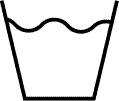
Machine Wash is the most common laundry symbol. It indicates that the clothes are durable enough to withstand the pressure caused by a washing machine.
Do Not Wash
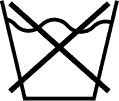
The Do Not Wash symbol tells you that the specific clothes are not suitable for the regular laundry routine. The Do Not Wash symbol is close to the image of the Machine Wash symbol but with a big cross mark.
Machine Wash: Gentle or Delicate
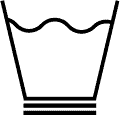
Not all clothes that are “Machine Wash Ready” are created equal. It’s important to see the care label first before dumping them into the washing machine. Gentle or Delicate symbols usually have two line bars below the Machine Wash symbol. When you see this symbol, separate clothes from regular washing to the Gentle or Delicate batch.
Machine Wash: Permanent Press
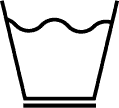
Permanent Press, also known as the wrinkle control cycle, means the clothing needs a slower spin cycle and even warm water. The water at this particular temperature helps prevent or remove some of the wrinkles, while the slower spin will reduce the wrinkle effect from washing.
Hand Wash
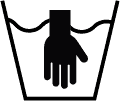
As advised from the care label, if you see your clothes with a tub icon with a hand inside, it’s highly suggested to never put them in a washing machine. Washing machines can be equipped with Gentle or Delicate options, but if you see this symbol on your clothes, it’s better not to risk it. Instead, use the traditional way of washing in the sink or small tub, and manually wash it using your hands and with mild laundry soap.
Machine Wash Heat Level: Cold
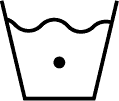
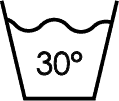
The Cold Heat Level icon usually has a dot sign in the washtub icon in your care label. Some washing machines have a cold water option that ranges from 15°C to 30°C. Most modern washers today are well-designed to handle cold washing. Even more, there are laundry soap detergents now that are specialized in working with cold water to enhance the overall result.
A pro-tip: using cold water will help to slow down the shrinking of fabrics and make their color last. Cleaning-wise, it can remove several stains from clothing such as food stains and makeup smudges.
Machine Wash Heat Level: Warm
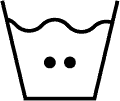
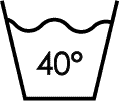
Like the Machine Wash Heat Level: Cold symbol, the Machine Wash Heat Level: Warm symbol shows the washtub icon, but with two dots in the middle. The washing machine’s warm option usually gives about 40°C or 105°F water temperature. Washing with a warm water temperature is suitable for heavy soiling.
Machine Wash Heat Level: Warm-Hot
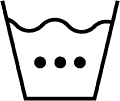
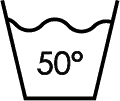
Similar to the previous symbols, the Machine Wash Heat Level: Warm-Hot symbol has the washtub icon with three dots in the middle. These dots signify that the clothes can take hotter water temperature, about 50°C or 120°F.
Take note that washing at this level has its pros and cons. It can effectively remove the heavy soiling much quicker compared to a warmer level but it can also shrink your garments. Be warned!
Machine Wash Heat Level: Hot

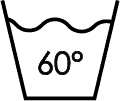
The Machine Wash Heat Level: Hot symbol shows the washtub icon with four dots. This option allows the machine to wash your garments at 60°C or 140°F water temperature. Using hot water temperature is the most potent way to eradicate the most stubborn dirt from garments. However, keep in mind that using it may not just shrink the items but also have colors fade. Again, always check the care label of your garments before using hot water.
Machine Wash Heat Level: Sanitize

The Machine Wash Heat Level: Sanitize symbol uses the hottest water temperature of around 70°C or 160°F. The Sanitize option is best for dirty rags as it can effectively remove heavy dirt, stains, as well as eliminating germs. The Machine Wash Heat Level: Sanitize may also come in the washtub with five dots image.
Chemical Cleaning Symbols
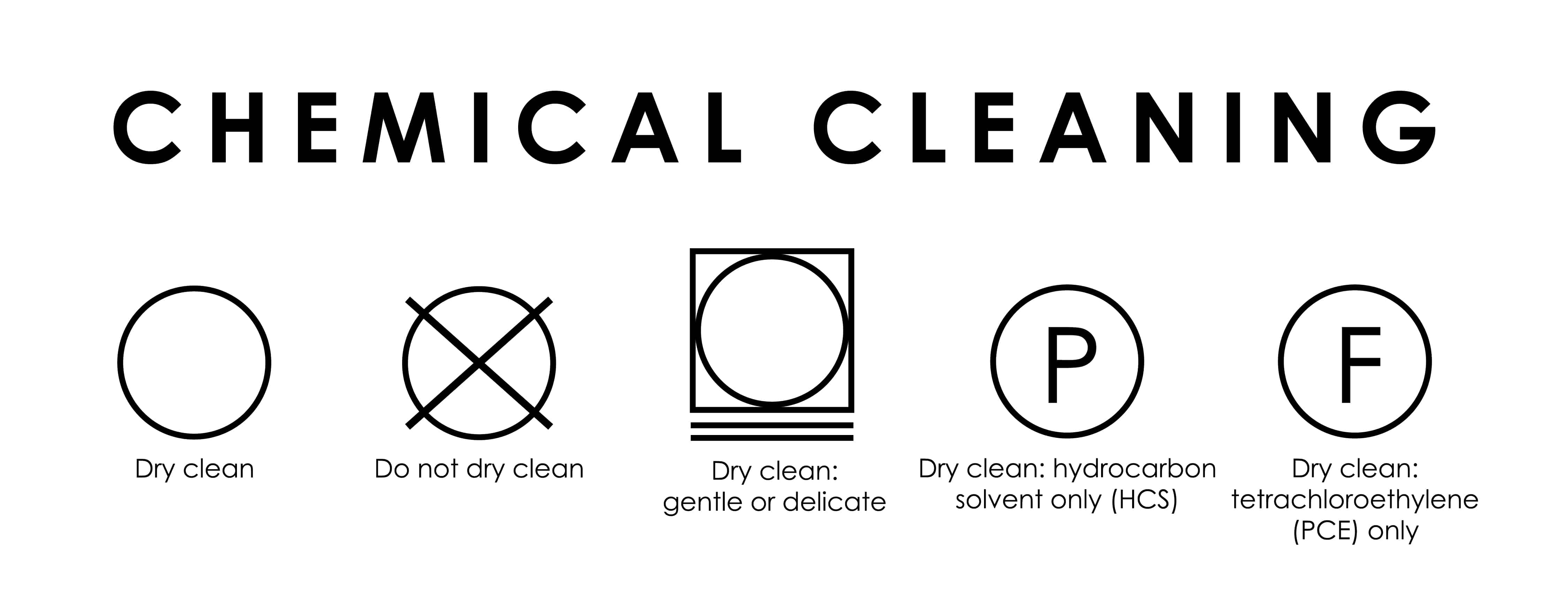
Dry Clean


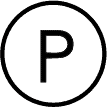
If the care label of your clothes or garments has a circle symbol, the manufacturer is instructing you to dry clean the item. There are different kinds of dry cleaning solvents in the garments. To go with that, the circle symbol can have various types such as a circle with a letter F, or P inside it. Those letters will tell the dry-cleaner what solvent to use. Watch the video to see how dry cleaning works.
Do Not Dry Clean
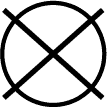
The Do Not Dry Clean symbol is easily recognizable. The Dry Clean circle icon marks a huge cross on it, telling you that the garment should never be under the process of dry cleaning.
Dry Clean: Gentle or Delicate
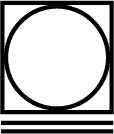
It’s not just the machine wash that has gentle or delicate symbols, dry cleaning has one, too. And much like the machine wash, the Dry Clean: Gentle or Delicate symbol has line bars underneath the circle icon indicating the level of precaution to dry cleaner. Keep in mind that if you perform a regular wash to a dry clean only garment, there’s a very high probability that that item will shrink.
Bleaching Symbols

Bleaching Allowed

Whenever you see an empty triangle icon in your item, it means it’s perfectly okay or safe to bleach it. Bleaching will help you brighten or whiten clothes and effectively remove even the peskiest stains. If there is mildew or mold from the clothes, trust that bleaching also has the capability to eliminate it.
Do Not Bleach


The Do Not Bleach symbol is easily recognizable as it’s just a Bleaching Allowed triangle symbol stamped with a big cross mark. You may also encounter a similar symbol but in full black, this also represents Do Not Bleach. If you accidentally bleach a fabric that’s not suitable or fit for bleaching, it can cause permanent damage to the fabric’s color.
Non-Chlorine Bleach If Needed

The Non-Chlorine Bleach If Needed symbol usually has the triangle shape of the Bleaching Allowed symbol, but with two slanting lines inside the triangle. Typically, you’ll see the Non-Chlorine Bleach If Needed symbol in colored clothing, which is also known as oxygen or color-safe bleach. Be sure to wash light and dark clothes separately and use the proper settings for your clothes. When you’re done, your clothes will look good as new!
Bleaching With Chlorine Allowed

Chlorine bleach is made up of sodium hypochlorite and water. Apart from whitening your garments, it removes soil and organic matter and kills bacteria and viruses. It’s important to never mix chlorine bleach and oxygen bleach as it will cause a chemical reaction not only harmful to your garments but also to your lungs.
Natural Drying Symbols

Line Dry
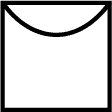
The Line Dry or Hang Dry symbol shows an icon of a drooping line inside a square. Drying clothes by hanging can help prevent heat damage caused by dryers. Harsh tumble dry may also cause distortion of the clothes size and shape. Thus, line drying is suitable for fabrics such as delicate jeans and underwear.
Dry Flat
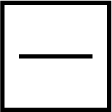
The Dry Flat symbol is a square with a horizontal line in the middle. This symbol means that the fabrics or garments must be lying flat to dry, instead of hanging up. Delicate fabrics such as woolen clothes need to dry flat to avoid losing their shape.
Drip Dry
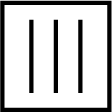
The Drip Dry symbol is a square symbol with three vertical lines in the middle. When you choose this option for your machine, it allows your clothes to remain relatively wet after the process. Likewise, if you’re performing a hand wash, don’t wring or squeeze the fabric too much. When you can hang your clothes on the hanger, let it drip, and you will see how the clothes will need very little to non-ironing when they are finally dry.
Dry In The Shade

The Dry In The Shade symbol is a square icon that usually has two slanting lines on the top left. When you see a Dry In The Shade symbol on your garment’s care label, it’s highly suggested not to expose your items to direct sunlight as a form of drying. Look for a shady spot for it to slowly dry and don’t also use a machine dryer.
Tumble Drying Symbols
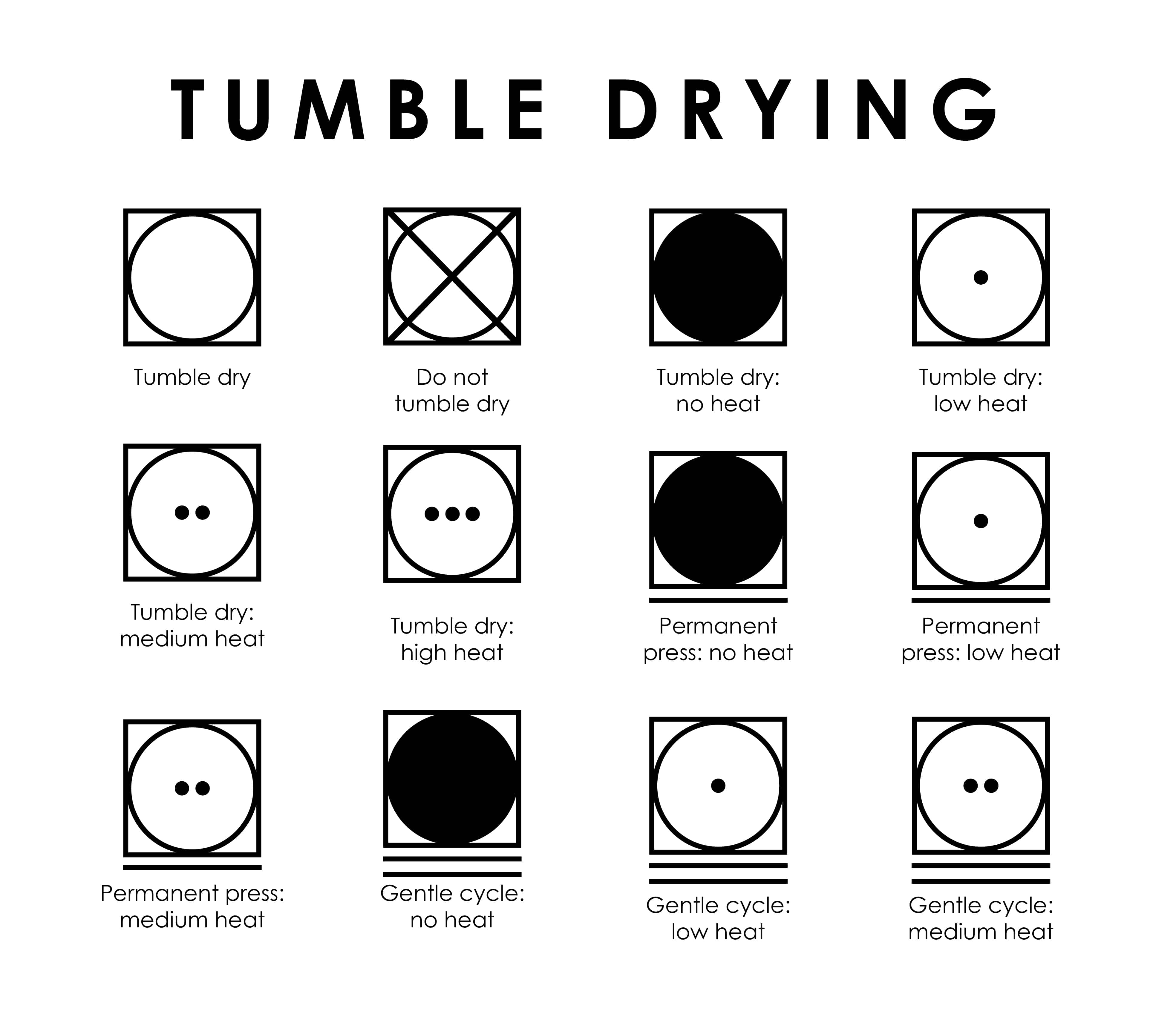
Tumble Dry
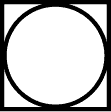
Tumble dry is best for loosely woven fabrics or anything with embroideries like sports jerseys, iron-on decals, beading, and sequins. Now, it’s equally important to dry the spandex or exercise clothing on low heat because it will protect the fabric from fading, fraying, and stretching. The Tumble Dry symbol is a square icon with a big circle inside it.
Do Not Tumble Dry
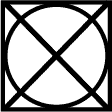
If you see the Do Not Tumble Dry icon in your care label, it just means that do not dry the item in the dryer, and simply hang it out to dry. Usually, you may dry the clothes in a dryer once or twice at the most if you really need to, however, you’ll be sacrificing its longevity if you continue to do so. The Do Not Tumble Dry symbol has the same icon as the Tumble Dry symbol just with a big cross mark across it to distinguish it.
Tumble Dry Normal Cycle: No Heat
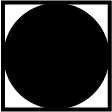
The Tumble Dry Normal Cycle: No Heat symbol features a square with a big dot inside it which almost covers the whole square. The Tumble Dry Normal Cycle: No Heat symbol in your care label indicates that you can machine dry the clothes provided that there is no heat or you use the air-only cycle.
Tumble Dry Normal Cycle: Low Heat
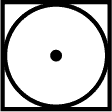
The Tumble Dry Normal Cycle: Low Heat is best for delicate items. Since this option uses minimal heat, the drying process will take much longer. On the flip side, garments will last have a longer lifespan especially if you use this option for your items that can tolerate high heat drying. The Tumble Dry Normal Cycle: Low Heat symbol shows the Tumble Dry icon with a small dot in the middle.
Tumble Dry Normal Cycle: Medium Heat

When you spot this, your basic dryer cycle should not exceed 65ºC. This setting will help reduce the possibility of shrinkage as the clothes are dried. Hence, it may take about 40 minutes or more to dry an average load of laundry. In some cases, fabrics such as jeans and towels take more time. The Tumble Dry Normal Cycle: Medium Heat symbol shows the Tumble Dry icon with two dots in the middle.
Tumble Dry Normal Cycle: High Heat

High heat is suitable for bed sheets and for the sanitation of pre-washed underclothes or apparel. Take note that this symbol says that the temperature should not exceed 75ºC. This setting is the fastest to dry up garments as it would only take about 30 minutes. The Tumble Dry Normal Cycle: High Heat symbol has the Tumble Dry icon with three dots in the middle.
Permanent Press: No Heat
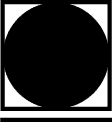
Permanent Press: No Heat is very similar to the Tumble Dry Normal Cycle: No Heat icon, but with a horizontal line beneath it. The process performs a lot of tumbling action but no heat. As a result, the No Heat Permanent Press settings reduce wrinkling from heat-sensitive fabrics and no-iron fabric finishes.
Permanent Press: Low Heat
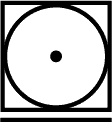
The Permanent Press: Low Heat symbol shares the same icon with Tumble Dry Normal Cycle: Low Heat symbol, but with a horizontal line beneath it. Regardless of the heat level, the primary objective of the permanent press (both washers and dryers) is to reduce the wrinkles. But for Low Heat Permanent Press, the cool rinse at the completion of the washing cycle along with the lower heat setting of the dryer will limit wrinkles from forming right from the start.
Permanent Press: Medium Heat
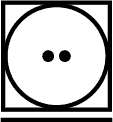
The Permanent Press: Medium Heat symbol is very similar to the Tumble Dry Normal Cycle: Medium Heat symbol, except that it has a horizontal line below it. As its name suggests, the permanent press cycle only utilizes a medium level of heat to limit wrinkling and, at the same time, avoids the damage that high heat can generate. Although the permanent press does not totally guarantee that the clothes will come out from the dryer in a total wrinkle-free status, nevertheless, it’s still a very acceptable method to follow.
Gentle Cycle: No Heat
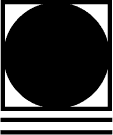
The Gentle Cycle: No Heat symbol is similar to the Permanent Press: No Heat symbol but only it has two lines under its icon instead of one. As this option clearly indicates, the gentle drying cycle is the best for delicate fabrics. Although it’s not advisable to put women’s delicates such as panties and bras in the dryer even if it’s on No Heat Gentle Cycle. There are other thin or lacy fabrics that fit in better, just check your care label first.
Gentle Cycle: Low Heat
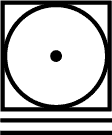
The Gentle Cycle: Low Heat symbol has the same icon as Permanent Press: Low Heat symbol but with two lines under its prime image. Like the Low Heat Permanent Press, the Low Heat Gentle Cycle works pretty much the same, but gentler. So if you want your garments to last longer, and if you have the time (remember that using this consumes more time than the usual), this option should be a wiser choice for your clothing —though nothing really beats the simple Air Drying in the shade.
Gentle Cycle: Medium Heat
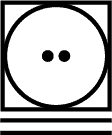
The Gentle Cycle: Medium Heat symbol also features the Permanent Press: Medium Heat symbol but with two lines. The Medium Heat Gentle Cycle option is the “best hybrid” to use if you’re looking for gentleness. It will not consume too much time and it works really in between. But again, the key here is to double your care label if your item is suited for dryers to avoid damages.
Ironing
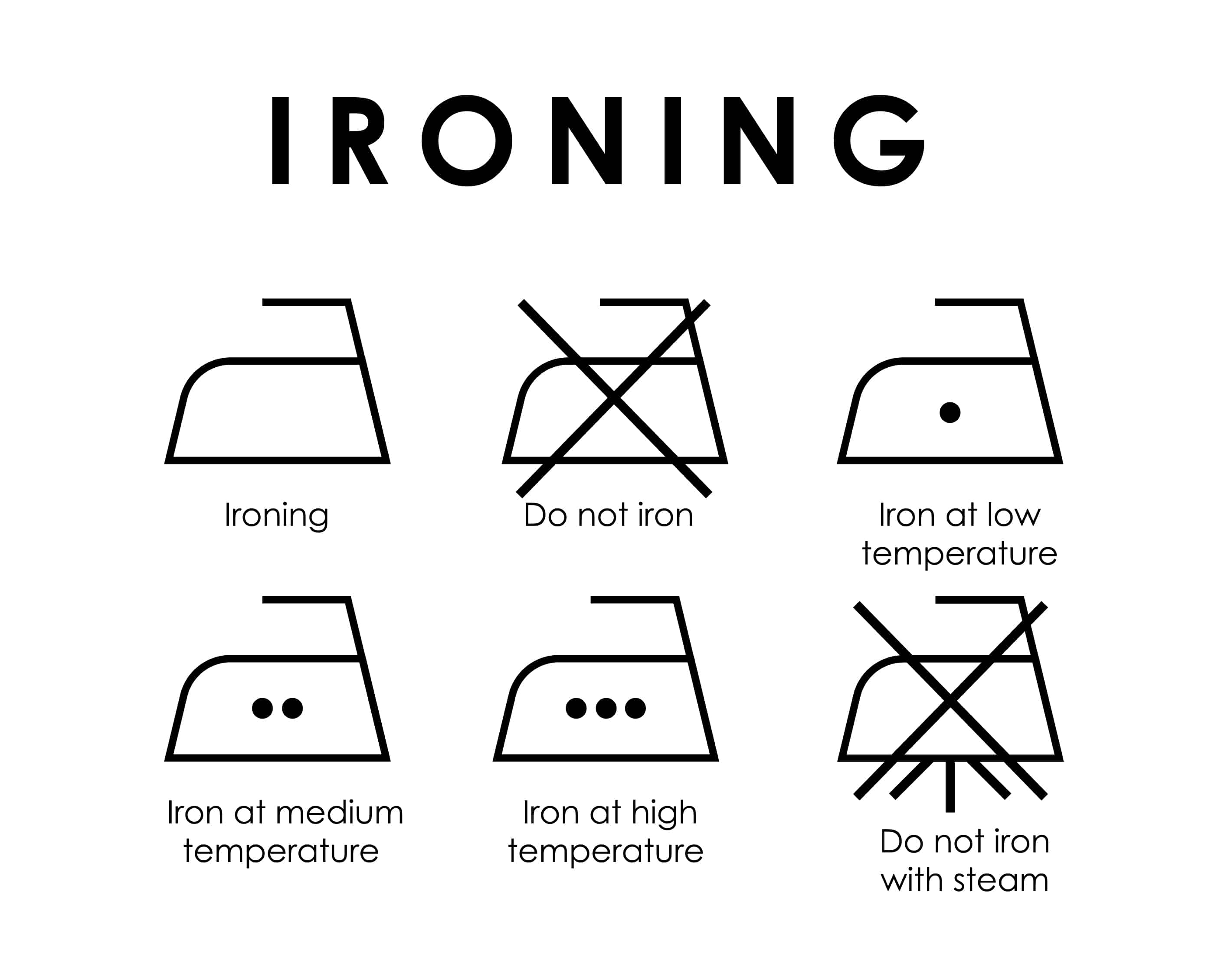
Do Not Iron

The symbol is the easiest icon to recognize among all of the laundry symbols because of its simplicity — a big cross mark on the iron symbol. It tells you that the materials made from that item are not safe for ironing. If you hate ironing, you may choose apparel made from polyester, spandex, lyocell, rayon, cashmere, wool, and knits as these fabrics do not need ironing.
Iron At Low Temperature

This Iron At Low Temperature symbol has an icon of iron with a dot inside it. This indicates that the garments or fabrics must be ironed at the lowest temperature, the maximum of which is 110ºC. It is also advisable to lay the garments inside out when ironing.
Iron At Medium Temperature

This care label for Iron At Medium Temperature shows an icon of iron with two dots. It indicates that the garments can be ironed at a medium temperature with a maximum temperature of 150ºC. To protect your garments, it is always better to try the iron first in a hidden patch of fabric to test its heat level. Fabrics such as silk, flannel, and cashmere are commonly fine with medium heat.
Iron At High Temperature

This Iron At High Temperature symbol shows an icon of iron with three dots. It is the highest temperature of the iron with a maximum temperature of 200ºC. Cotton, linen, and denim are some of the fabrics that can handle this setting.
Do Not Iron with Steam

The Do Not Iron with Steam symbol is made up of the iron symbol with two or three short lines at its bottom, representing steam or water, and a cross mark enveloping it. It means to not use steam on the particular garment while ironing. Using steam is the fastest way of ironing because it assists in getting rid of wrinkles swiftly.
When the steam penetrates the fibers of the fabric, the heat coming from the iron will make them stay in place which gives you an effortless ironing time. If you check your care label and it doesn’t contain the Do Not Iron with Steam symbol, then it’s good to go.
Conclusion
Dirty clothes can collect microorganisms which can lead to skin infections. Foul body odor can start from wearing clothes with the fungi and bacteria found on them. Unless disposable clothing will become a trend in the future, laundry machines and laundry symbols will be with us for a good while. Knowing or at least getting familiarized with laundry symbols will help anyone avoid ruining their garments, and will ultimately make life so much easier.
Was this page helpful?
Our commitment to delivering trustworthy and engaging content is at the heart of what we do. Each fact on our site is contributed by real users like you, bringing a wealth of diverse insights and information. To ensure the highest standards of accuracy and reliability, our dedicated editors meticulously review each submission. This process guarantees that the facts we share are not only fascinating but also credible. Trust in our commitment to quality and authenticity as you explore and learn with us.


